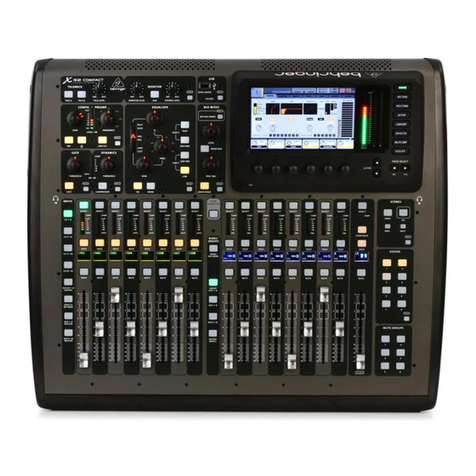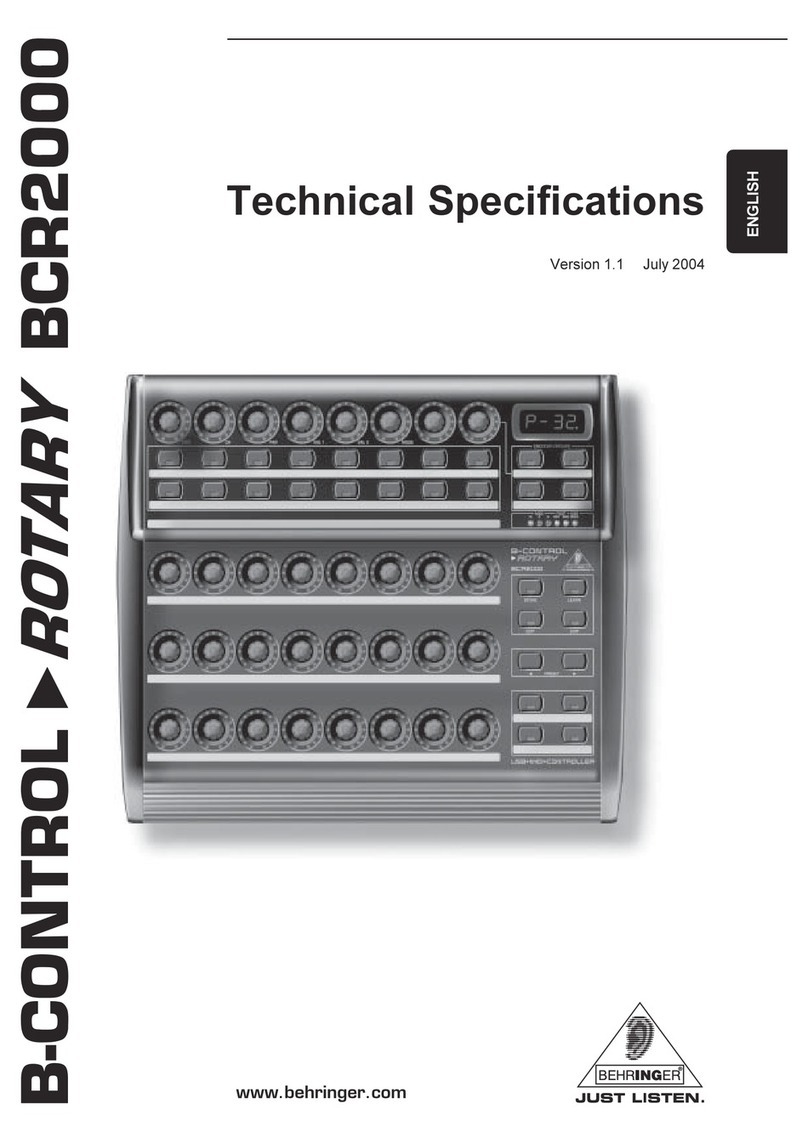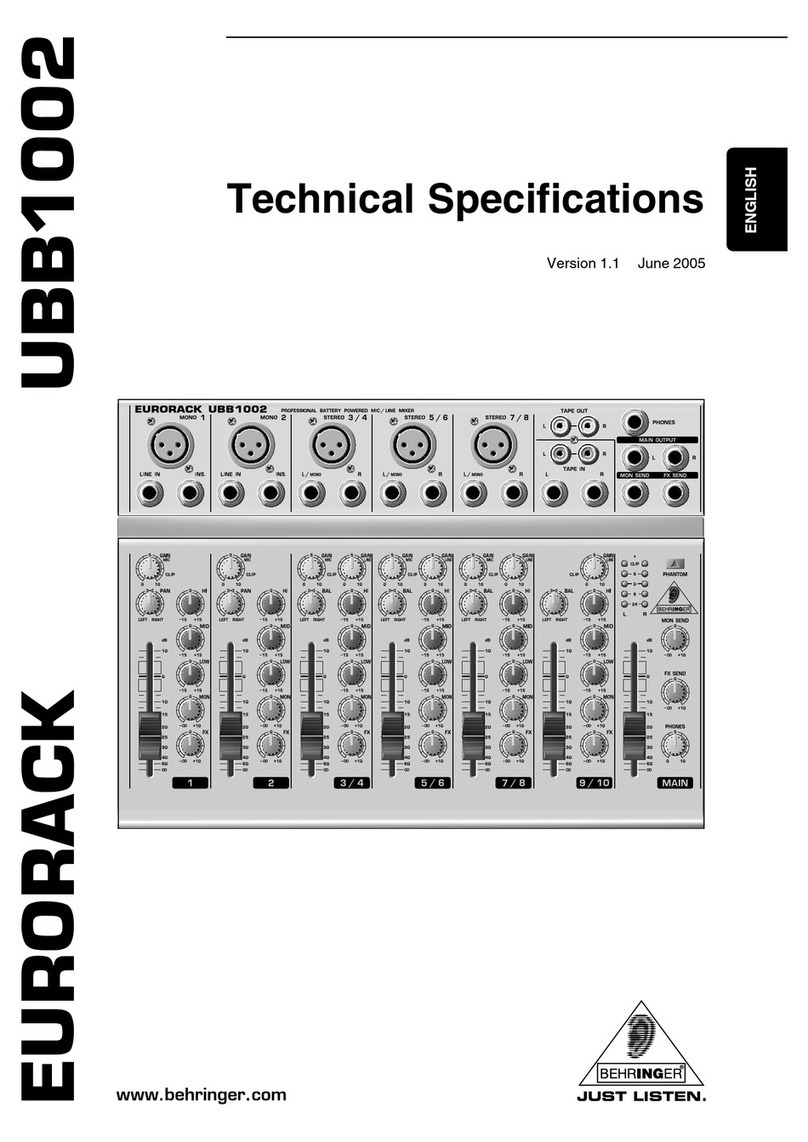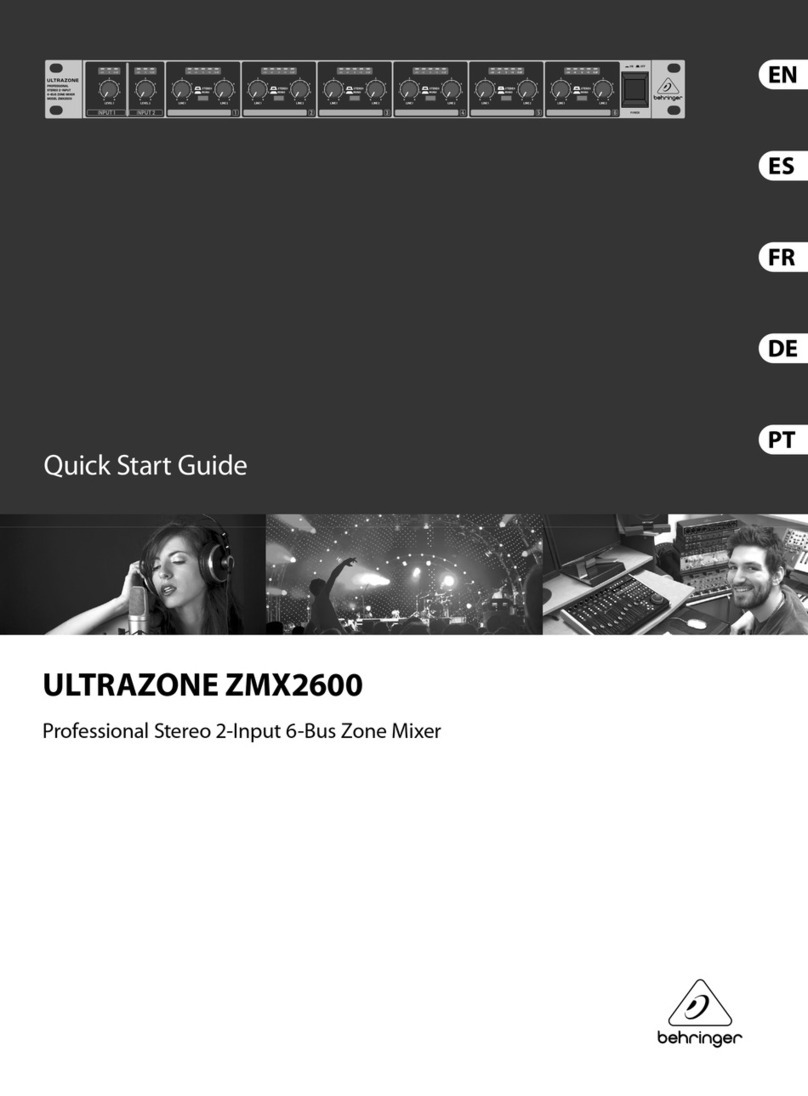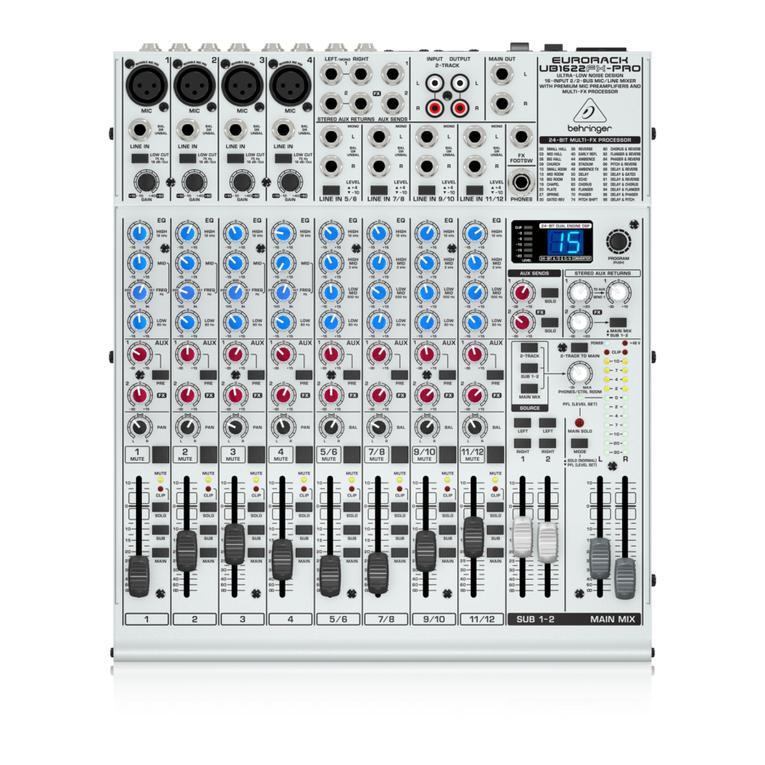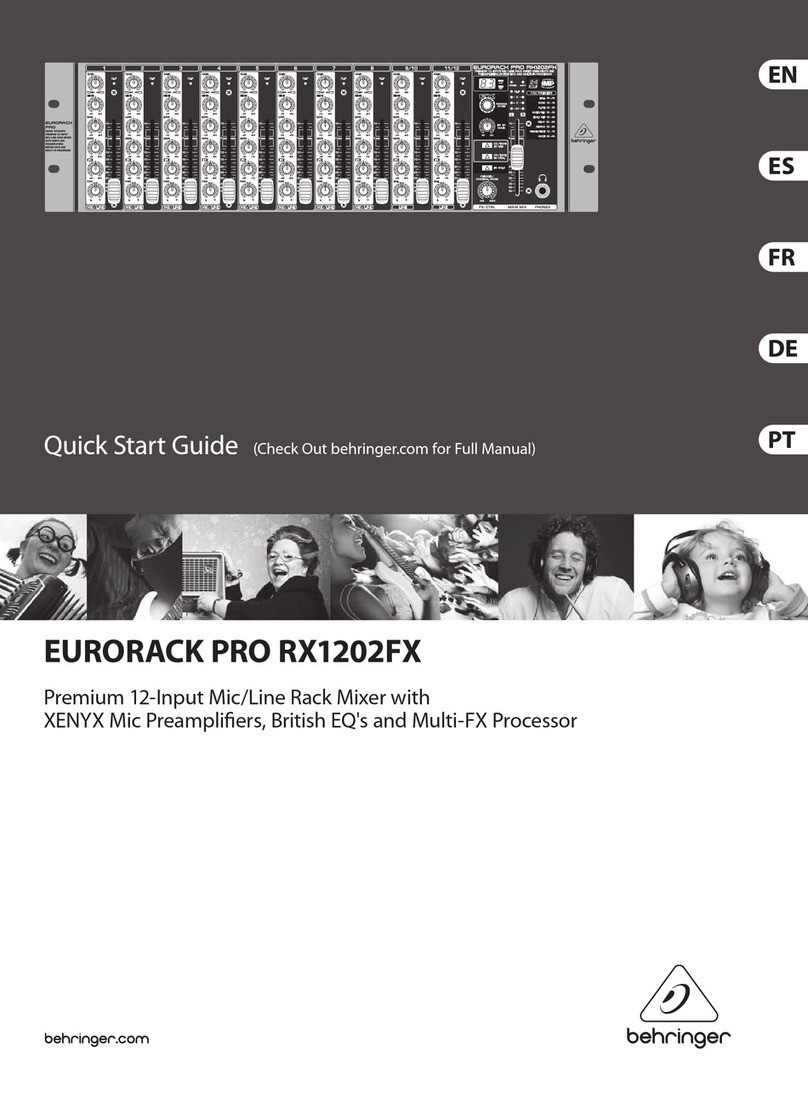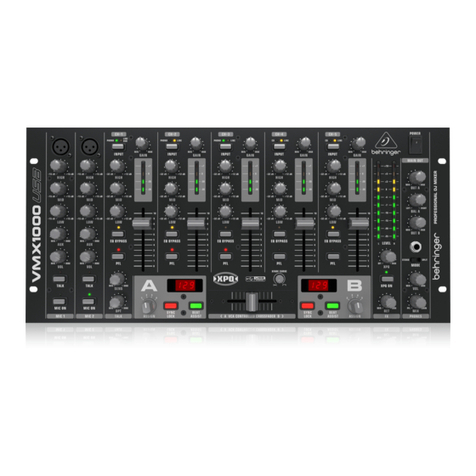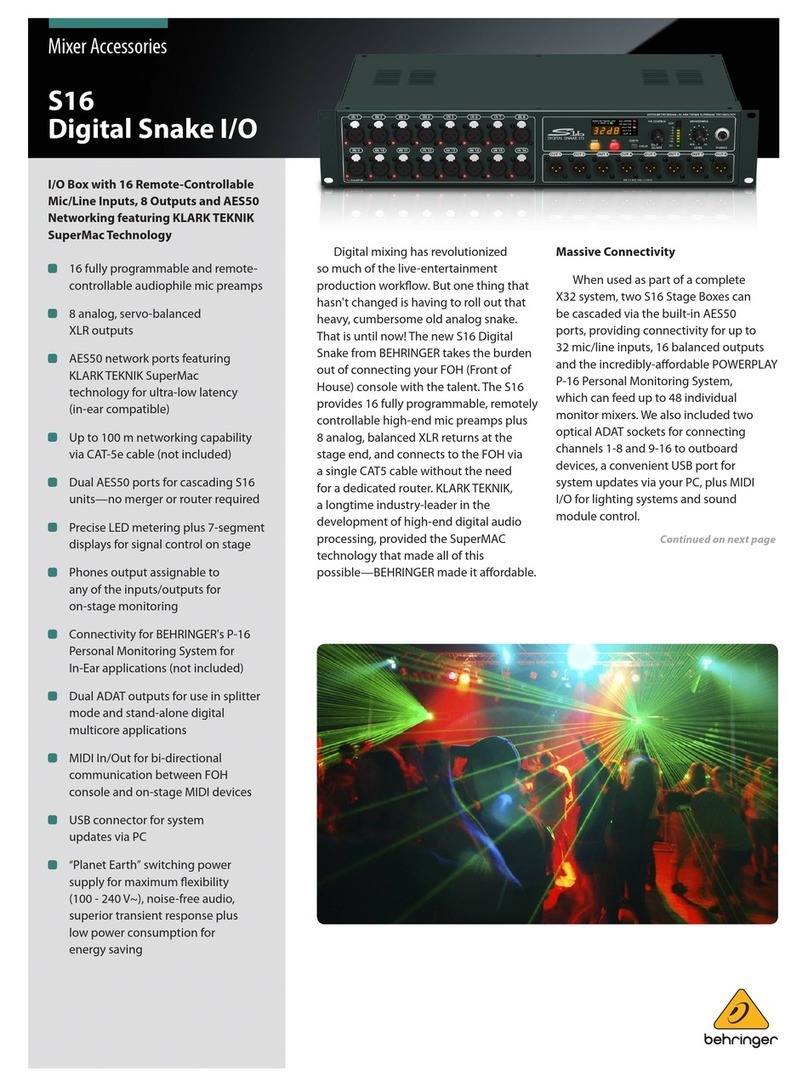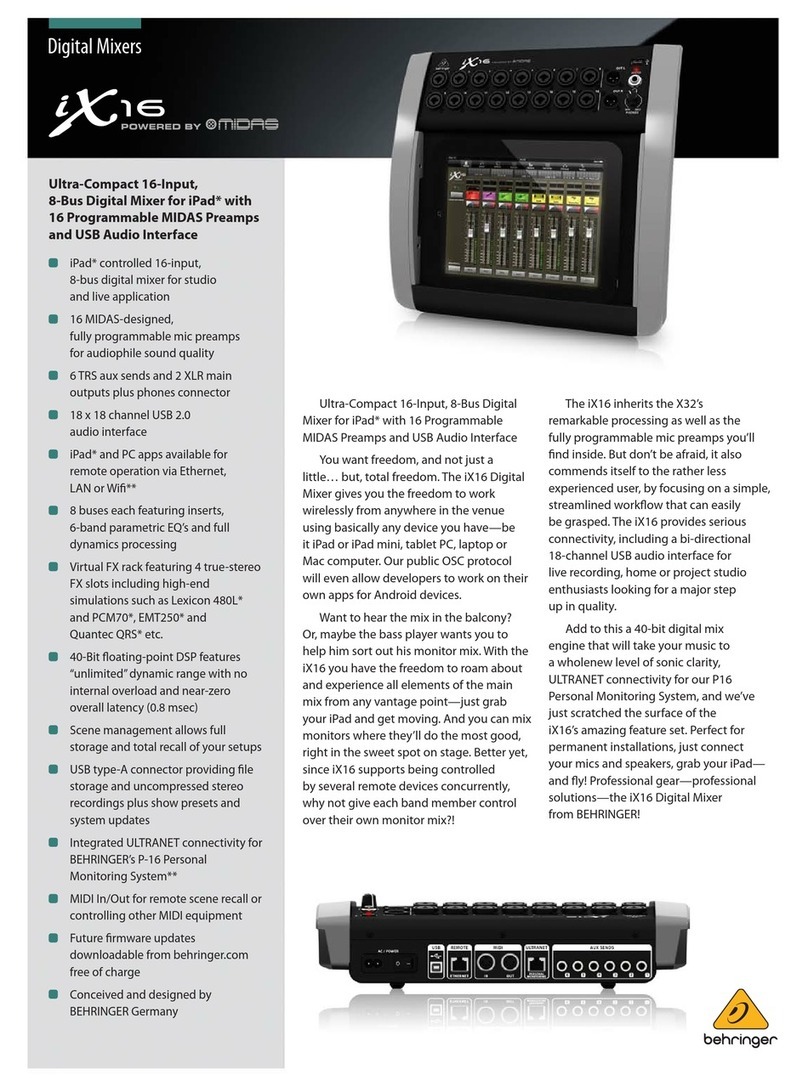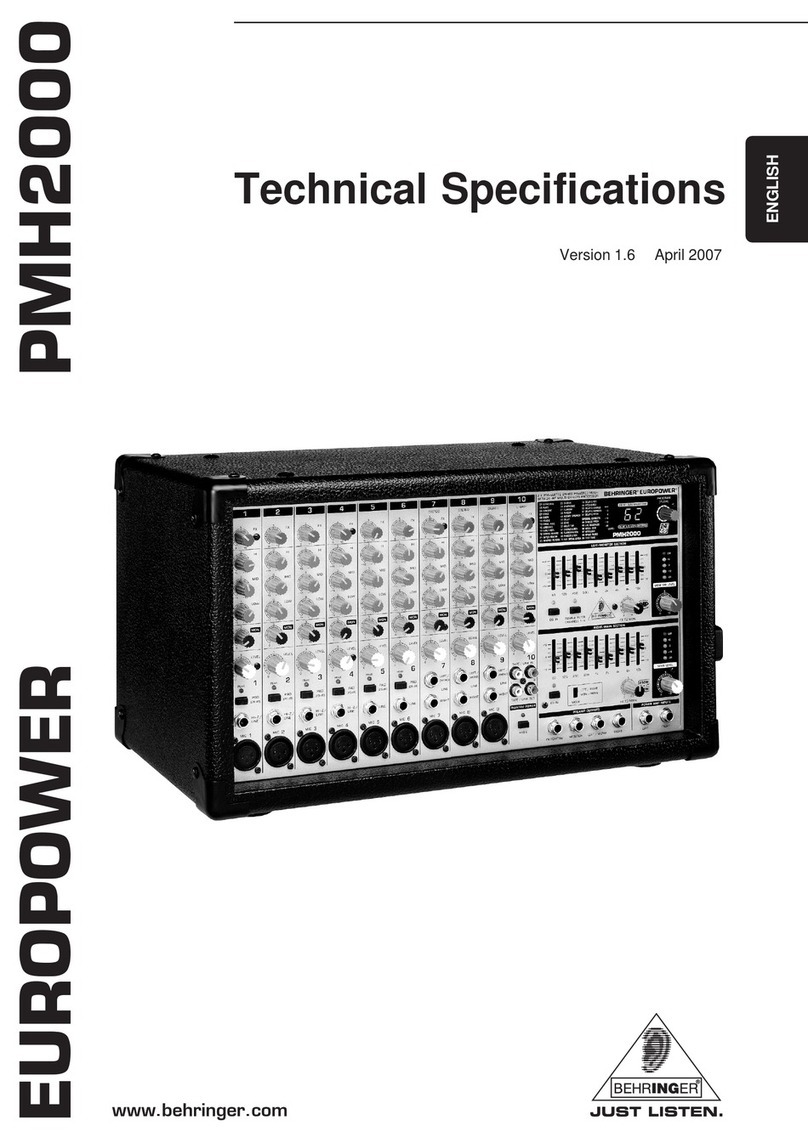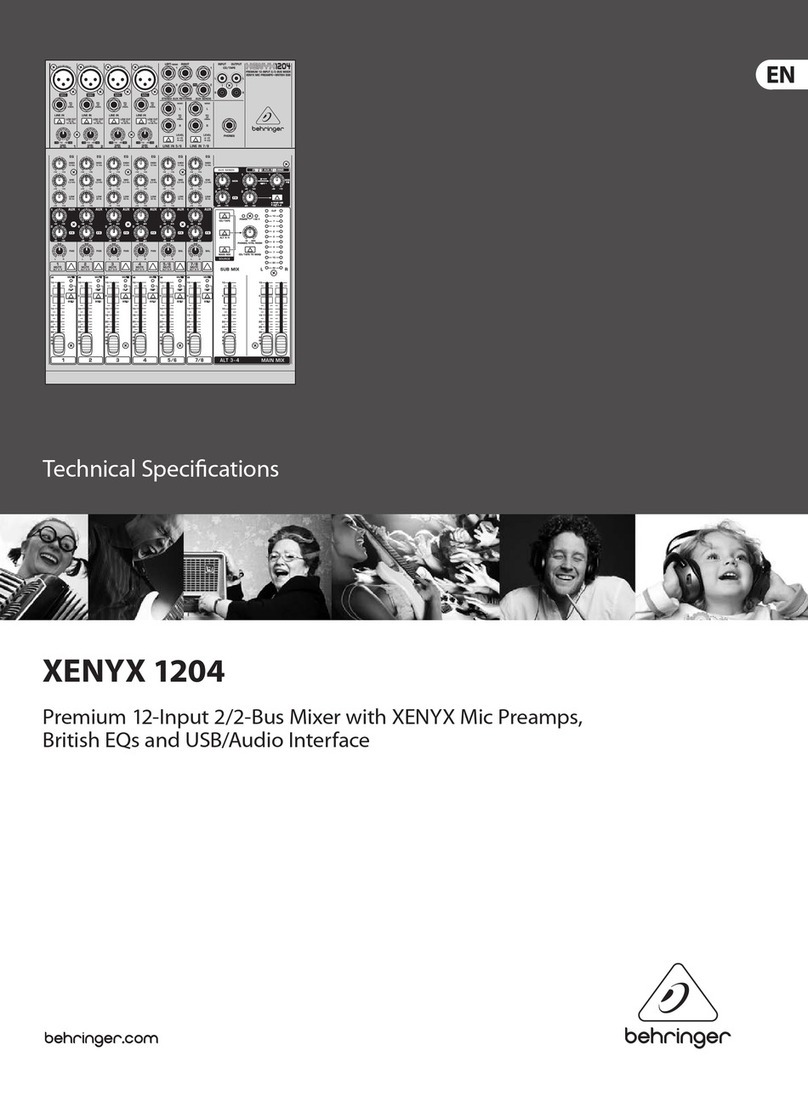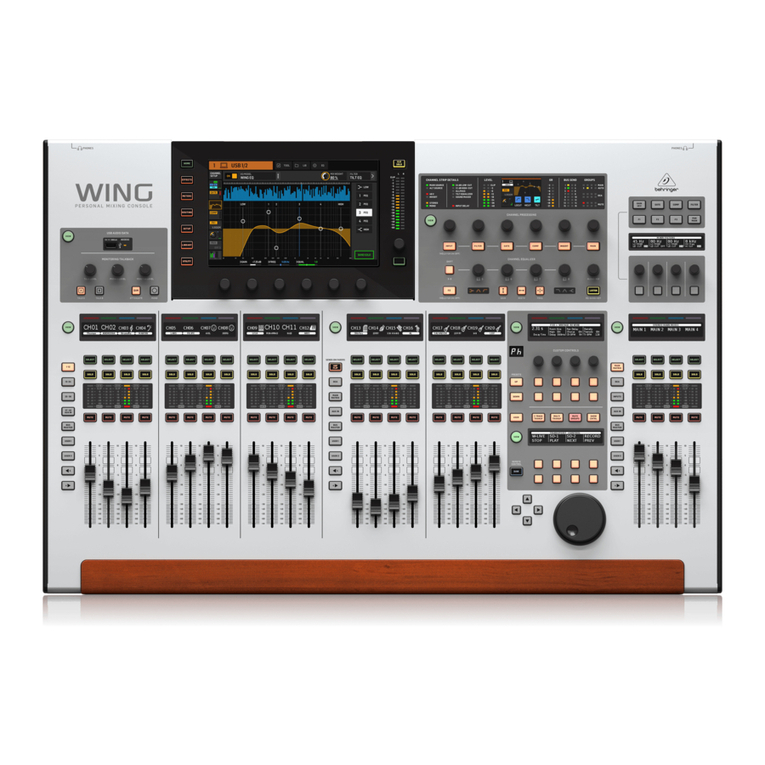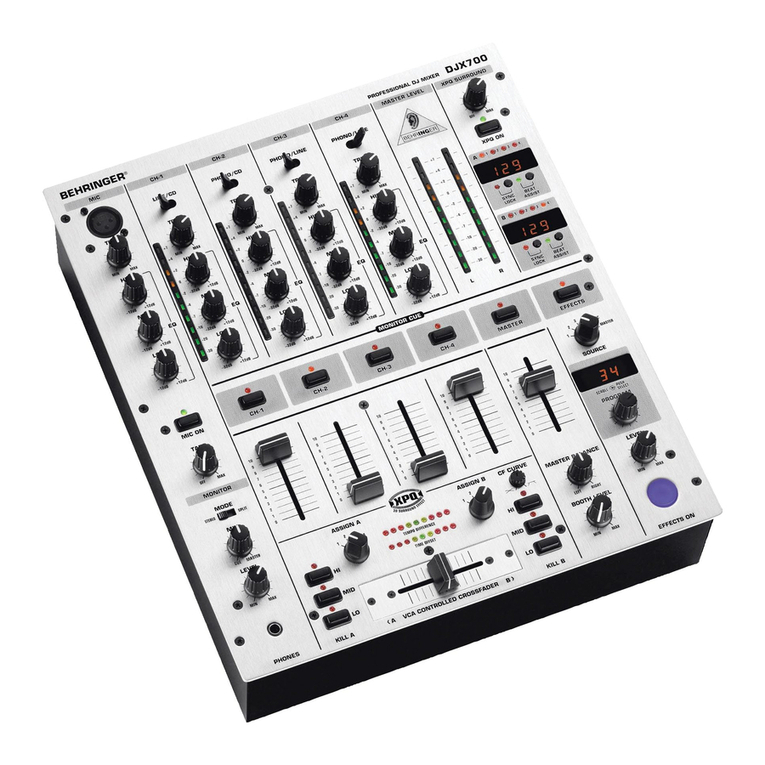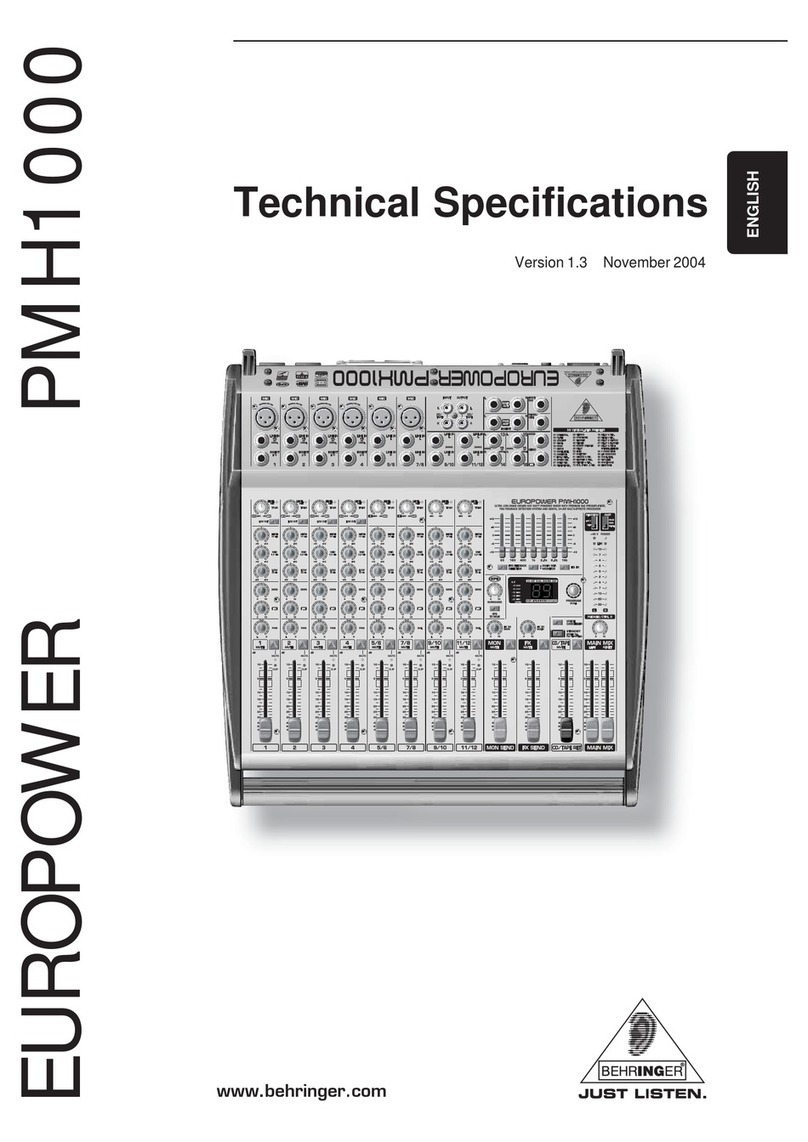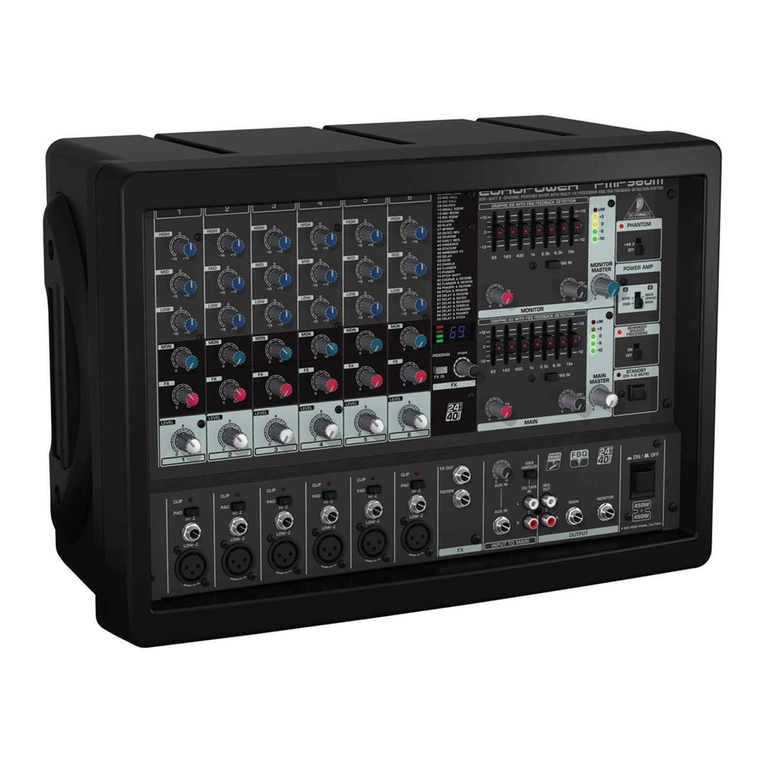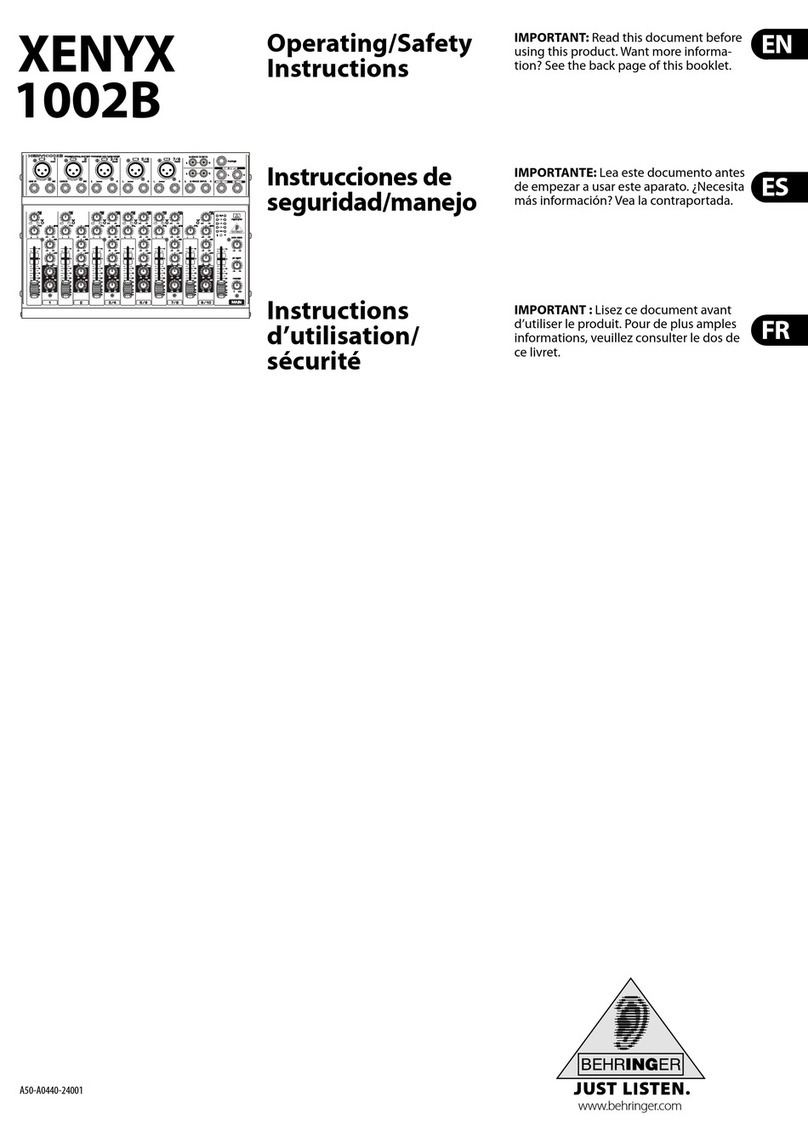
5
XENYX 1222FX
FBQ Feedback Detecti n System
The FBQ Feedback Detection System, integrated into the
graphic equalizer, is one of the most outstanding characteristics
of this mixing console. This ingenious circuitry lets you immediately
recognize and eliminate feedback frequencies. The FBQ
Feedback Detection System uses the LEDs in the frequency
band faders of the graphic EQ to indicate the critical frequencies.
This way, what once used to be a labor-intensive search for
feedback frequencies is now an activity that even a child could
master.
The microphone channels feature high-end XENYX Mic
Preamps that compare well with costly outboard preamps in
terms of sound quality and dynamics and boast the following
features:
s130 dB dynamic range for an incredible amount of headroom
sA bandwidth ranging from below 10 Hz to over 200 kHz for
crystal-clear reproduction of even the finest nuances
sThe extremely low-noise and distortion-free circuitry
guarantees absolutely natural and transparent signal
reproduction
sThey are perfectly matched to every conceivable
microphone with up to 60 dB gain and +48 volt phantom
power supply
sThey enable you to use the greatly extended dynamic range
of your 24-bit/192 kHz HD recorder to the full, thereby
maintaining optimal audio quality
British EQ
The equalizers used for the XENYX Series are based on the
legendary circuitry of top-notch consoles made in Britain, which
are renowned throughout the world for their incredibly warm
and musical sound character. Even with extreme gain settings
these equalizers ensure outstanding audio properties.
Multi-effects pr cess r
Additionally, your XENYX mixing console has an effects
processor with 24-bit A/D and D/A converters included, which
gives you 100 presets producing first-class reverb, delay and
modulation effects plus numerous multi-effects in excellent audio
quality.
The XENYX mixing consoles are equipped with a state-of-the-
art switched-mode power supply (SMPS). Unlike conventional
circuitry an SMPS provides an optimum supply current regardless
of the input voltage. And thanks to its considerably higher
efficiency a switched-mode power supply uses less energy
than conventional power supplies.
USB/Audi interface
The USB interface supplied with the unit is a perfect match for
the XENYX Series and serves as a powerful recording interface
to your PC or MAC®. It supports the digital transmission of signals
on up to four channels with max. 48 kHz and extremely low
latency. When wired to the CD/TAPE INPUT and OUTPUT
connectors, the interface transfers the stereo mix from the
console directly to a computer. Both the recording signal and the
playback signal from the computer can be monitored at the same
time. In this way, you can use several recording runs to produce
complete multi-track recordings.
CAUTION!
+We w uld like t draw y ur attenti n t the fact that
extreme v lumes may damage y ur hearing and/ r
y ur headph nes r l udspeakers. Turn the MAIN
MIX faders and the PHONES c ntr l in the main
secti n fully d wn bef re y u switch n the unit.
Always be careful t set the appr priate v lume.
1.1 General mixing console functions
A mixing console fulfils three main functions:
sSignal pr cessing:
Preamplificati n
Microphones convert sound waves into voltage that has
to be amplified several-fold then, this voltage is turned into
sound that is reproduced in a loudspeaker. Because micro-
phone capsules are very delicate in their construction,
output voltage is very low and therefore susceptible to
interference. Therefore, mic signal voltage is amplified
directly at the mixer input to a higher signal level that is less
prone to interference. This higher, interference-safe signal
level has to be achieved through amplification using an
amplifier of the highest quality in order to amplify the signal
and add as little noise to it as possible. The XENYX Mic
Preamp performs this role beautifully, leaving no traces of
noise or sound coloration. Interference that could take place
at the preamplification level could affect signal quality and
purity, and would then be passed on to all other devices,
resulting in inaccurate sounding program during recording
or playback.
Level-setting
Signals fed into the mixer using a DI-box (Direct Injection) or
the output of a sound card or a keyboard, often have to be
adjusted to the operating level of your mixing console.
Frequency resp nse c rrecti n
Using the equalizers found in each channel strip, you can
simply, quickly and effectively adjust the way a signal
sounds.
Effects mixing
In addition to the effects processor contained in your mixer,
using the insert connectors on the mono channels and
both aux busses lets you insert additional signal processors
into your signal path.
sSignal distributi n:
Individual signals adjusted at each channel strip are laid
out at the aux sends and returns, and are either fed into
external effects processors or fed back to the internal
effects processor. Then, the signals are brought back into
the main mix either via the aux return connectors or via
direct internal wiring. The mix for the on-stage musicians is
also created using the aux sends (monitor mix). Similarly,
for example, signals for recording equipment, power ampli-
fiers, headphones and 2-track outputs can also be taken.
sMix:
All other mixing console functions fall under this vital
category. Creating a mix means primarily adjusting the
volume levels of individual instruments and voices to one
another as well as giving them the appropriate weight within
the overall frequency spectrum. Likewise, youll have to
sensibly spread individual voices across the stereo image
of a signal. At the end of this process, adjusting the level of
the entire mix to other equipment in the signal path is required
(e. g. recorder/crossover/amplifier).
The interface of BEHRINGER mixing consoles is optimized for
these tasks, enabling you to easily keep track of the signal path.
1.2 The users manual
The users manual is designed to give you both an overview of
the controls, as well as detailed information on how to use them.
In order to help you understand the links between the controls,
we have arranged them in groups according to their function. If
you need to know more about specific issues, please visit our
website at http://www.behringer.com. Additional information and
explanations about various music industry/audio technology
terminology can be found on individual product pages as well as
in the glossary in the ULTRANET area of www.behringer.com.
1. INTRODUCTION
